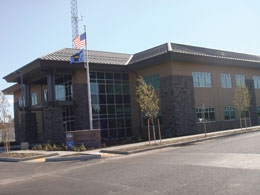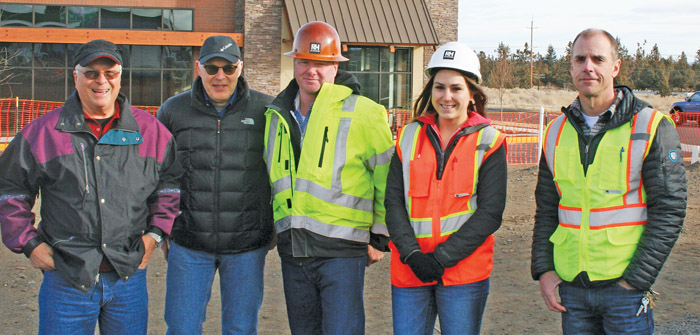 Operators recently received the all-clear to move into a state-of-the-art new $7 million building anticipated to meet Deschutes County 911 dispatch needs for the next two decades.
Operators recently received the all-clear to move into a state-of-the-art new $7 million building anticipated to meet Deschutes County 911 dispatch needs for the next two decades.
The transfer signaled a welcome switch for the telecommunications team which had been working out of a cramped 3,000 square foot headquarters in the nearby county sheriff’s office for the last 15 years.
Now the 911 service district has over 15,000 square feet of upper floor space, featuring the latest in audio-visual technology, as wells as administrative offices, training and conference rooms incorporating a designated Emergency Operations Center (EOC) which can be utilized by multiple agencies in the event of a major disaster.
The first floor of the two-story building on Poe Sholes Drive is being rented by Oregon State Police to accommodate its local patrol and investigation needs – including a cutting edge new crime lab – previously based in a smaller building leased from the county. The site also features a 150-foot communication antenna tower and 6,000 square feet outbuilding for storage needs.
Andy Jordan, who has been working as the interim director for Deschutes County 911 Service District, said: “The new facility is state of the art and will meet the needs of the department for the very distant future.
“The move into the new facility along with renewed energy within the department provides the backbone for one of the most professional 911 agencies in the Northwest.
“The staff that provides the top-quality services is among the most well-trained and dedicated anywhere, and residents of Deschutes County can be assured that their emergency calls and dispatch services will continue to be the best.”
The project is the culmination of efforts initiated in 2006, when the county contacted the OMNI consulting group to conduct a space needs study of the Deschutes County 911 facility.
The results indicated the organization was occupying only a third of the space it required at that time and needed significantly more space to accommodate anticipated future growth.
Based on the findings, and decreasing options for expanding in the former location, the county made a decision to co-locate the new 911 center with the Oregon State Police, with funding coming from a five-year levy voters passed in May 2008.
The project broke ground in July 2009 and was ready for a seamless call station transfer on August 11 this year, while other administrative functions included in the 41-strong workforce continue the relocation process.
Approximately a third of the space is dedicated to an emergency operations center and houses the latest technology in audio/video display and emergency management tracking.
The move also allows Deschutes County 911 to increase the number of dispatch consoles from 11 to 16, with an additional 4 dedicated to training.
Essentially, all communications with police (excluding OSP which utilizes a Salem base) fire and emergency medical services are handled through Deschutes County 911 – a 24-hour-a-day, 365-day-a-year operation covering 3,055 square miles of land and serving a population of over 160,000 residents.
Deschutes County also experiences a seasonal increase in the calls for service due to the swelling of transient populations due to the abundant recreation and tourism activity in the Central Oregon region.
Telecommunications staff work around the clock on 12-hour shifts; typically working four shifts in a row followed by four days off. Training for various positions is rigorous and can take up to a year to complete.
“Situational awareness” and teamwork are key qualities for the staff as agencies rely on coordination of communications, the verification of data and monitoring of each unit’s status in emergency incidents – on many occasions, telecommunicators are tasked with coordinating multiple agencies’ responses to significant or multi-hazard incidents.
Supervisor Chris Perry said: “The new space provides much-needed room to grow and the ability to increase efficiencies and capabilities, particularly through updated technology. Security has also been enhanced and we have the capability of monitoring various sections within the building.
“Another big step is having dedicated on-site training facilities rather than having to use other agencies’ space as we did in the past, as well as room to conduct conferences in the public safety realm.”
The project’s general contractor, Boise, Idaho-based Engineered Structures, Inc. (ESI) and architect LCA – whose website bills it as “a recognized regional leader in the design of justice facilities” – were selected after a qualification process; with LCA also having been involved in the county’s original public safety complex including the jail, sheriff’s office and probation service.
Principal Architect Russ Moorhead said: “The 911 dispatch component had adequate space when the original complex was built in the mid 90s, but quickly outgrew it as the area’s population began exploding.
“The new building features state of the art infrastructure, and as an ‘essential’ facility -which needs to stay intact in the event of a major disaster – it has been substantially reinforced with, for example, higher seismic resistance qualities.
“It also has back-up generating and fuel capacity so it can be self-sufficient in times of need, including an Uninterruptable Power Supply (UPS) in which a transfer to emergency power can be made without losing communications for even an instant.”
The sophisticated communications systems capacity includes the design and outfitting of space that can act as an emergency operations center where multiple agencies can work in concert in the case of a major incident.
An EOC is effectively a central command and control facility responsible for carrying out the principles of emergency preparedness and emergency management, or disaster management functions at a strategic level in an emergency situation, and ensuring the continuity of essential operations.
The EOC is typically responsible for the strategic overview, or ‘big picture’, of the disaster, and its common functions include collecting, gathering and analyzing data; making decisions that protect life and property, maintaining continuity of the organization, within the scope of applicable laws; and dissemination of those decisions to all concerned agencies and individuals.
Moorhead said the 911 floor included a ‘bunk room’ with laundry facilities in the case of extended stays for staff dealing with emergency situations.
The telecommunications operational hub incorporates the latest technology including a ‘video wall’ where multiple operators can insert critical information and utilize mapping software.
The building is also aiming for Leadership in Energy and Environmental Design (LEED) Silver certification, with Moorhead adding: “We followed many LEED guidelines related to the health of the building and its occupants.
“The space needed to be flexible to accommodate future growth, but also be light and airy, with much use of natural light balancing out powered illumination, particularly as people working in such dispatch centers are typically operating in a potentially high stress environment.
“Fresh air flow is also regulated based on sensor readings of carbon dioxide levels related to the number of people in the building at any given time, and automatically adjusted as appropriate.
“The building also went through a ‘flushing’, involving running fresh air via the HVAC system for 72 hours continually after the project was completed.
“Other sustainable practices employed included minimizing water usage through, for example, low-flow fixtures, the use of recycled materials in areas such as carpeting, and the donation of seventy per cent of construction waste to recycling. A solar array on the outbuilding will also supplement energy capacity.”
The building is primarily steel and concrete, with the exterior being of site-cast, tilt-up type, and features stone and brick veneers, together with front entrance and interior window shading.
The 150-foot communications antenna – substantially taller than the previous tower which was shared with the sheriff’s office – accommodates county 911 and OSP needs, together with ample capacity for future growth and channels, and Moorhead described the entire complex as “one of the most modern facilities of its
type on the West Coast.”




